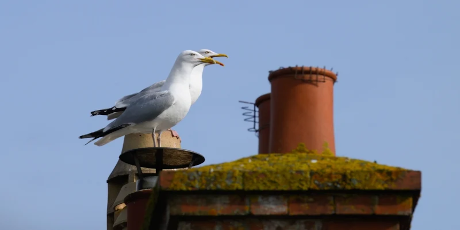Why we see so many gulls in our cities and towns 24 Jul 2023

Analysis: the migration of gulls to urban areas in search of food due to a decline of fish in the sea presents a conservation dilemma - Dr. Paul Hlloway, Department of Geography/ERI, UCC
Ireland is home to seven different breeding species of gull, with several more winter visitors. Like much of the natural world, gull numbers have been declining globally and nationally since records began. In recent years, populations have begun to stabilise, but both the Herring Gull and the Lesser Black-backed Gull remain on the Amber list of threatened bird species.
A large part of this stabilisation has been the success of urban populations so the plight of these species can be quite surprising to people. This is especially so as we see large numbers of Herring Gulls around our coastlines and urban areas.
Roof-top nesting by Herring Gulls has led to human-wildlife conflict, as these birds can be quite aggressive when it comes to food, as well as loud during anti-social hours. As we enter peak breeding season for these gulls, it's worthwhile considering that they embody a true conservation dilemma.
Why are natural dwelling birds decreasing in numbers?
The location and success of natural breeding populations and nest sites for Herring Gulls have been attributed to five main factors: the availability of food, risk of predation, the availability of suitable nest substrate for raising offspring, the presence and behaviour of conspecifics (i.e., other gulls), and the presence of a suitable climate.
A recent OSPAR Commission report suggests that widespread breeding failure of gulls in the Celtic Sea is most likely linked to declining fish availability, which is driven by overfishing and climate change. Overfishing is a debated topic, but recent reports are indicating that several stocks are being overfished in Irish waters, such as cod, herring and whiting. This is then compounded by changes in climate that are causing fish to shift their distribution in response to changing water temperatures. In short, there are simply not enough fish to sustain natural breeding populations of gulls.
Why are urban dwelling birds increasing in numbers?
If food supplies are declining in their natural habitats, there is no shortage in our urban centres. Due to this widespread availability, urban gulls can forage shorter distances, saving energy and obtaining more food, which promotes successful breeding and chick raising, with the diet of some urban gulls consisting almost exclusively of human refuse.
Our recent research in Dublin investigated which buildings Herring Gulls preferred to nest on. Building selection was hierarchical across spatial scales, but gulls chose buildings within towns that were closer to food sources (e.g., refuse bins) and streetlights. Food availability (location and visibility) clearly results in a preference or competitive advantage for selecting nest sites in urban areas; however, this is also one of the leading causes of human-gull conflict.
What human-wildlife conflicts are arising?
Gulls are kleptoparasitic, which means they take food from other gulls. It appears they have adapted their behaviour to include humans on their list of species they will target. This is the headline conflict, as the divebombing nature of their predation in the wild is often mimicked.
While incidences of food snatching are rare, they have the potential to cause significant impact and/or injury on those they are targeting. More regularly, gulls use human handling of food as a cue and the abundance of discarded waste, incorrectly secured refuse and infrequent collections can result in an abundance of food sources, creating littered streetscapes in the aftermath.
These birds are then transporting this waste into their natural environment, causing cascading impacts on other species. Where there is an overpopulation of any species, disease spread (contamination of water sources with Salomonella) and spill-over events (avian influenza) are an increasing concern, especially considering events of recent years.
How can the conservation dilemma be solved?
The most effective changes should be simple to implement; correct disposal of litter, use of closed refuse bins, and not feeding the birds, but the human-gull conflict won’t abate unless human behaviour changes. These solutions do work. Take the humble pigeon, long seen as a nuisance in London. During lockdown when people were at home and not feeding them (yes that still happens), they moved on looking for alternative sources of food, evidenced by a shift in the diet of urban peregrine falcons from pigeons to parakeets.
Maintaining eye contact with gulls has also been found to deter them from making direct contact with people and discarded food. Small changes in our behaviour will have a profound impact on managing this conflict, while allowing space for urban wildlife to thrive.
The key component in human-wildlife conflict resolution is empathy. Recent calls for (and implementation of) culling across certain parts of Ireland indicates there is currently little of this for urban gulls. Conservation is nuanced, but tensions are amplified in urban settings where the opportunity for human-wildlife conflict is more prevalent.
However, should we not aim to protect urban wildlife, especially as urbanisation is one of the leading cause of species decline worldwide. We could draw on experiences from other cities. How do people and leopards co-exist in Mumbai? What about mountain lions in Los Angeles? The list goes on.
Other cities have built upon their colonies of urban wildlife through ecotourism, such as the Mexican free-tailed bat of Austin or the starling murmurations of Rome (incidentally this is another species that is on our Amber list). Perhaps there is an opportunity that can benefit both our cities and our gulls. This debate won’t disappear anytime soon as populations of urban gulls continue to rise, but this also highlights the need to identify long-term solutions that are symbiotic for both humans and gulls.